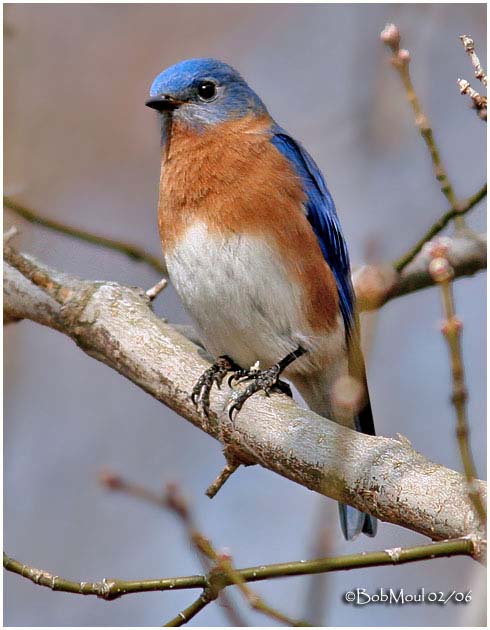
Eastern Bluebird
Sialia sialis
Passeriforme Order – Turdidae Family
BIOMETRICS:
Length: 16-21 cm ; Wingspan: 25-32 cm ; Weight: 28-32 g
LONGEVITY: up to 10 years
DESCRIPTION:
Eastern Bluebird male is uniformly deep blue on upperparts. It has chestnut throat, sides of neck, breast and flanks. Belly and undertail coverts are white.
We can see some black or grey on tips of wings and tail feathers. Blue of the head becomes duller between chestnut throat and breast.
Dusky bill is short and relatively thin. Legs are short and black, as feet. Eyes are black.
Adult female is similar but duller than male with more grey.

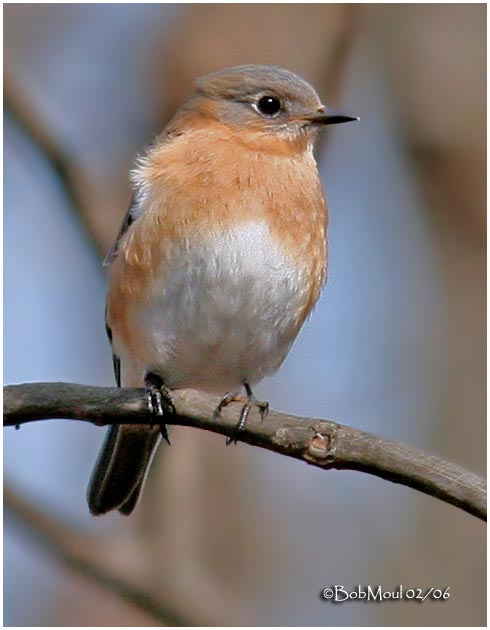
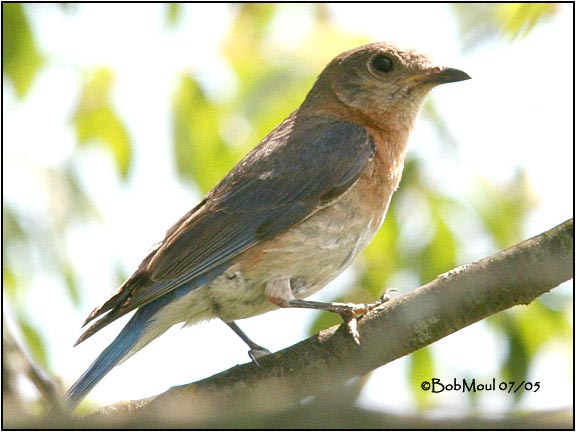
Immature are greyish brown above, with wing feathers tipped in blue. Cheeks and scapulars are streaked with whitish. Underparts are white, with streaked brown chin, throat, breast and flanks. Belly is white.
VOICE: SOUNDS BY XENO-CANTO
Eastern Bluebird’s call is a musical and rising “chur-lee”, extending in song to “chur, chur-lee, chur-lee”, repeated several times. They have several calls for different purposes. It may have a dry chatter, but its mainly song is a rich warbling whistle consisting in short phrases “tu-wheet-tudu”.
HABITAT:
Eastern Bluebird lives in open woodlands, farmlands, orchards, and suburban areas. Preferred nesting habitats are open areas with few trees and forest edges.
RANGE:
Eastern Bluebird breeds in eastern Rocky Mountains, from southeast Canada to Gulf of Mexico, and into Mexico and Honduras.
It winters in southern parts of its breeding range.
BEHAVIOUR:
Eastern Bluebird hunts from a perch, diving down on ground to catch a prey. Sometimes, it uses flycatching and gleaning. It has good eyesight and can locate small food from more than 100 feet away.
Eastern Bluebird is monogamous, and pair stay together during whole season, and may breed together for more than one season.
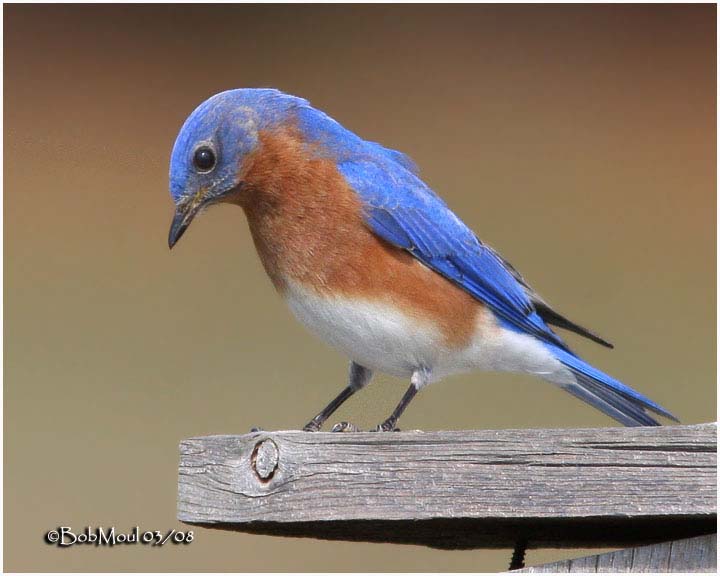
During courtship display, male sings and flutters in front of the female with half open wings and fanned tail. Later, it perches close to female to preen her, and sometimes, it will offer some food. Male perform displays at nest cavity, bringing nest materials to the hole, going in and out, and waving its wings while it perches above the hole, in order to attract female.
Eastern Bluebirds become aggressive and may fight between them, during breeding season. Eastern bluebird male utters a song like a warning cry, when an intruder approaches. If female is alone, she begins to sing, hoping a protective male. Both adults also flick wings and warble when predator is nearby.
Out of this period, Eastern bluebirds are very social birds, and they gather in big flocks to forage.
Eastern Bluebird is partially migratory, flying to south when food becomes scarce and weather too bad.
FLIGHT:
Eastern Bluebird may fly with a speed of 17 miles per hour. They travel in flocks of 30 to 40 individuals.
REPRODUCTION:
Eastern Bluebird male selects several nest sites, but female may start to build nests in several sites, before to choose one and built its nest. She needs about 4 to 6 days to do it, but this time may vary.
Nest is often situated in old woodpecker hole, at about 3 to 40 feet above the ground, in a dead tree, or in nest box. It is made with dry grasses, rootlets and weed stems. Sometimes, nest is entirely made with pine needles. It is cup-shaped, and lined with fine materials such as grasses, sometimes hair and feathers.
During this time, male may carry nest materials, but it spends most of its time to guard its mate.
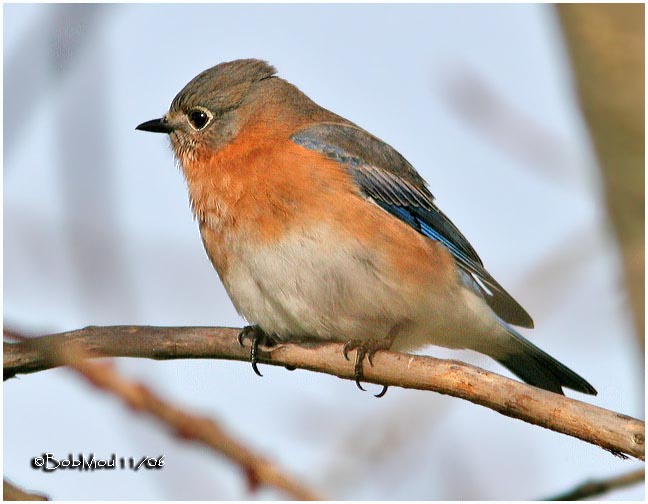
Female lays one egg each day. Clutch may consists of 3 to 5 sky blue or white eggs, smooth and glossy.
Eggs laid by one female are the same colour. Other coloured eggs indicate that a second female has laid into the same nest.
Incubation lasts about 12 to 14 days, by female. Altricial chicks hatch one or two days of each other and female brood them for these few days. Both parents tend the young, which are brooded at night if weather is cold.
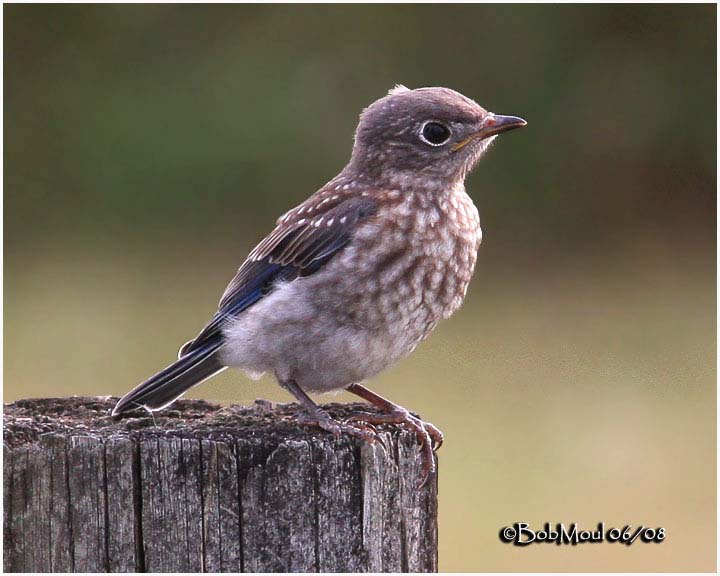
They fledge at about 16 to 22 days, but they depend of their parents for 3 to 4 weeks more. They are fed primarily by insects. They reach their sexual maturity at one year old.
This species produces two clutches per season. Male continues to take care of first clutch, while female begins the second. Young from the first brood may help their parents to tend the second clutch.
DIET:
Eastern Bluebird feeds on insects and their larvae, such as caterpillars, butterflies, moths, grasshoppers, and spiders. It also feeds on berries, earthworms, snails, and other invertebrates.
PROTECTION / THREATS / STATUS:
Eastern Bluebird populations have been declining, due to cold weather, negative effects of use of pesticides to control fire ants, and competition for cavity nests. But with the nest box campaigns, their numbers are now increasing, in spite of habitat loss.
Eastern Bluebirds have some predators, such as chipmunks and flying squirrels for eggs and chicks, and snakes, hawks, cats and raccoons for chicks and adults.
Fr: Merlebleu de l’est
All : Rotkehl-Hüttensänger
Esp : Azulillo de garganta canela
Ital: Uccello azzurro orientale
Nd: Oostelijke Bluebird
Sd: Östsialia
Photographs by Bob Moul
His website:
Nature Photography
Text by Nicole Bouglouan
Sources :
HANDBOOK OF THE BIRDS OF THE WORLD Vol 10 by Josep del Hoyo-Andrew Elliott-David Christie - Lynx Edicions - ISBN: 8487334725
FIELD GUIDE TO THE BIRDS OF NORTH AMERICA - National Geographic Society - ISBN: 0792274512
All About Birds (Cornell Lab of Ornithology)
Animal Diversity Web (University of Michigan Museum of Zoology)
What Bird-The ultimate Bird Guide (Mitchell Waite)
Wikipedia (Wikipedia, The Free Encyclopedia)